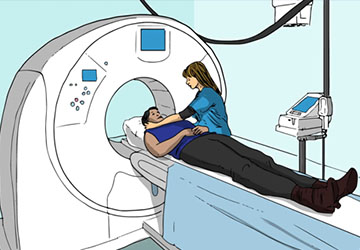Authors: Andrew Ciupek, PhD, Associate Director, Clinical Research, GO2 for Lung Cancer; Anita K. McGlothlin, Senior Director, Economics & Health Policy, GO2 for Lung Cancer; Angela Criswell, MA, CPS, Director, Quality Screening and Program Initiatives, GO2 for Lung Cancer
 Lung cancer screening using low dose computed tomography (LDCT) is currently the only proven method to find lung cancer at an early stage. This is critical because lung cancer is more easily treated in the early stages and early detection has led to significantly reduced lung cancer deaths. Currently, who should be screened is determined based on their age and smoking history. However, there are many more people that could benefit from screening than are currently eligible.
Lung cancer screening using low dose computed tomography (LDCT) is currently the only proven method to find lung cancer at an early stage. This is critical because lung cancer is more easily treated in the early stages and early detection has led to significantly reduced lung cancer deaths. Currently, who should be screened is determined based on their age and smoking history. However, there are many more people that could benefit from screening than are currently eligible.
Recently, the Centers for Medicare and Medicaid Services (CMS) put out new recommendations that lowered from age 55 to 50 and from 30 pack years to 20 to be eligible for screening. This is important since CMS recommendations determine whether or not Medicare will pay for a procedure and could inform what private insurance plans choose to cover. Expanded coverage for lung cancer screening has a huge, life-saving impact for the at-risk population.
Expanded coverage nearly doubles the eligible population.
On February 10, 2022, Medicare updated their national policy, broadening its coverage of low-dose CT screening for lung cancer to be more in line with the current U.S. Preventive Services Task Force (USPSTF) lung cancer screening guidelines and to bring forward preventive services benefits in the Medicare population.
The American Cancer Society predicts that over 131,000 Americans will die in 2022 from lung cancer. By broadening coverage of lung cancer screening, Medicare is expanding the opportunity to save lives through early detection and reduce disparities in how lung cancer impacts underserved and minority populations. Screening is the best way to turn this tide and has the potential to save 30,000-60,000 lives every year. It’s crucial to share the news about the expanded coverage of annual screening so that all who are eligible know and can take action.
Should you or your loved ones get screened?
Primary requirements for annual screening
The primary requirements for screening eligibility focus on age and smoking history.
- AGE: Are you at least 50 years old?
- SMOKING HISTORY: Do you currently smoke? If you’ve quit smoking, has it been within the past 15 years? How heavily do or did you smoke?
When it comes to age, most private insurances follow the USPSTF guidelines and cover lung cancer screening for individuals aged 50-80, while Medicare coverage starts at 50 but ends at 77. To determine if someone’s smoking history places them at higher risk for lung cancer, USPSTF and Medicare both now require a 20-pack year history for lung cancer screening eligibility. To calculate this, think about how many packs of cigarettes you or your loved one’s smoke/d per day, on average—a 20 pack year history means you smoked a pack a day on average for 20 years, or two packs a day for 10 years.
Other risk factors
While Medicare and private insurance coverage for lung cancer screening is determined by age and smoking history (and these are by far the largest risk factors for lung cancer) there are other things that may also increase your risk including a family history of lung cancer, having another cancer or COPD, radon and asbestos or diesel fume exposure. If this is you, tell your doctor. A low-dose CT scan might be right for you.
Lung cancer screening saves lives—so don’t wait!
GO2 for Lung Cancer makes it easy to learn about lung cancer screening—we have information on risk factors, details on screening eligibility and information on where to go to get screened. To learn more about screening, or to find out if you or a loved one are at risk, explore our screening resources or call our HelpLine at 800-298-2436.

[…] screening may restrict some people from having access to LDCT (learn more about these guidelines here). GO2 is optimistic that more people will have access to LDCT in the […]